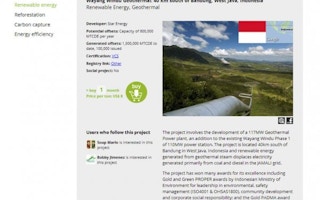First there was crowd-funding, now, a Singapore-based social enterprise has launched a portal for ‘crowd-offsetting’.
Set up by a team led by Andreas Birnik, adjunct sustainability professor at the National University of Singapore, Andreas Birnik, CarbonStory is a crowd-funding platform for climate change projects.
Think Kickstarter, Kiva and Watsi, popular platforms that use the Internet to gather numerous individuals to raise funds for a project, venture or cause. Inspired by these crowd-funding sites, CarbonStory encourages people to reduce their own carbon emissions through the purchase of carbon credits, which in turn support environmental projects.
The team, joined by two of Birnik’s former tech industry colleagues Olof Lundström and Victor Cruzate, hopes CarbonStory will bring climate change issues to the forefront of public consciousness.
It explains to users how the excessive accumulation of greenhouse gases, in particular carbon emissions or carbon dioxide emitted in the course of human activities such as growing food or running transport, is detrimental to the climate and the world.
To help solve climate change, an individual can trade or offset his or her own carbon emissions for carbon credits.
The site does this in an engaging way, combining a welcoming user interface with graphics and non-technical descriptions for users, with social media features such as integration with Facebook.
To boost the visibility of the site, the three founders recently launched the beta version of their website at the latest SXSW or the South by Southwest (SXSW) Conference and Festivals in Austin, Texas.
It was in this crowd-drawing event that social networking giants Twitter and Four Square made their own breakthroughs, according to Birnik. So rather than CarbonStory be seen as an NGO, he says, “We aspire to all the buzz words of such companies including being fast-moving, lean, flat, meritocratic and born global.”
He mentions that this approach is a new way to address climate change and its mitigation. Carbon offsetting programmes so far have targeted the corporate market rather than the consumer.
The CarbonStory website also explains how the volume of the voluntary offset market is vastly smaller compared to regulated or compliance markets like the European Union Emission Trading Scheme (EU ETS), which is the EU scheme for trading and reducing of industrial greenhouse gas emissions.
On the other hand, individuals may be aware of climate change, but only a few consider their carbon emissions, and even less think of ways to reduce their carbon footprint. The impetus for the founders then was “to make a real impact towards fighting climate change,” says Birnik. CarbonStory seeks to change the game of how people relate to climate change as something “rather abstract and doesn’t have a human face” to one with a “personal connection.”
Birnik notes that Singaporeans have one of the highest carbon footprints per person in Asia. Depending on which metrics are used, this ranges from between 10 to 20 tonnes. Its footprint is higher than several Western European countries, albeit lower than the 26 tonnes of average Americans, according to Birnik. He realised, through teaching, that any intended solution should “capture both the hearts and minds of students.”
Birnik decided to collaborate with Lundström and Cruzate to create CarbonStory, which not only appeals to students, but also to the wider public. The platform also addresses other factors that have hindered the carbon market from taking off, such as its technical nature and vague project offerings.
Birnik recounts how carbon offset providers tend to list unspecified projects for sponsorship. This inhibits people from selecting projects they like, comparing to choices by other providers, and verifying the authenticity of the projects. Another concern is the calculator used in computing the carbon emissions. Most are configured for only a few countries.
Lundström says CarbonStory is “very easy to use.” The calculator, developed by Birnik during his Master’s degree at Harvard, is more standardised and location-specific. Projects are wide-ranging and straightforward in their actions, so choosing projects to sponsor is convenient and transparent.
The Facebook integration and profile page of projects supported and offset tally likewise add another layer of ease, whether in spreading the word for climate change mitigation or continuing this carbon neutral lifestyle.
Birnik says, “The more users we get onto the Carbon Story platform, the greater our collective impact.”
As for Cruzate, he says, “Climate change mitigation is a serious topic but we want to make the experience accessible so that a lot of people will want to participate. We cannot afford to wait for politicians to solve this challenge. We need to act now and Carbon Story makes meaningful climate action easy.”
CarbonStory dedicates a detailed page to each climate change project like this renewable energy project in Indonesia. credit: CarbonStory
CarbonStory’s 3 steps to go carbon neutral:
First, calculate your personal or household carbon footprint based on lifestyle and location.
Second, select green projects to buy carbon credits from. A wide variety is available by category (such as renewable energy or reforestation), country and price. Each project has a detailed page stating potential and generated offsets, a succinct description and photos and videos.
Third and last, share your carbon offsets on Facebook. Show friends how helping address climate change can be done.










